Cruising at 10,500 feet above a blanket of white clouds, the warm sunshine streamed through the canopy and filled the cockpit. The air was smooth as glass, and more than three miles ticked by with each minute. Over the humming of the engine, music filled the headset. Settling back to enjoy the view while the autopilot flew us to our destination, my more attractive half was dozing off in the back seat. Life is good.
As we approach 10 years of flying with our Experimental F1 Rocket, I look back at all the hours spent in the workshop creating our magic carpet. The time in the shop is now a distant memory, and the pleasure we have today flying an airplane we built ourselves has returned a dividend of fun and adventure worth every minute invested in making it happen, with only a few instances of unplanned maintenance. During that period, it has otherwise proven to be a reliable, predictable, and fun companion, taking us across large swaths of the country without any mechanical delays.
A little over a decade ago, surrounded with unconnected parts in the workshop, a friend commented, “You aren’t just building an airplane. You’re building a time machine.” How right he was. Of course, any airplane has the potential to be a time machine when compared to a car, but as speeds start to approach 200 knots, the compression of distance into small amounts of time becomes very noticeable and excursions that would require days by car suddenly become possible in a weekend.
Many of our experiences with the Rocket are comparable to aircraft like the RV-4 and RV-8; the airplanes share a close lineage of design and layout, and while the Rocket might have a bit of an edge in performance, the practical difference in trip times is not very great.
We live in Houston, Texas. Despite being topographically challenged, it offers the geographic advantage of being centrally located, making it possible to get to either side of the country in less than eight hours.
Building an F1 Rocket
There’s a common joke among builders of just about anything. It goes something like: double the time and triple the cost. Ha-ha. Very funny. You’d think by the time I started the project, I would have figured out it’s not a joke.
Actually, it’s not quite as bad as that. In the end, it took a little over 3,000 hours to build the airplane, but that included a lot of time on customizations and homegrown work on items that many builders farm out. For example, I overhauled the engine myself, constructed the baffles from scratch, and built all the wiring harnesses. On the cost front, the final tally was about 50% more than my original budget, but that includes buying two EFIS and autopilot systems after the first one failed at year five.
The kit quality was very good. The workmanship of the finished parts was excellent. Many of the parts, which are extra-cost items on other kits, like air vents and tires, were included. Factory support was excellent, and there was an active builder’s group. There are also a number of builder web sites, which provided a big help on those head-scratching occasions.
One of the areas that consumed a lot of time was the original instrument panel. During the build, I was spending around 11/2 hours a day commuting to work. All that time looking at instruments in the car got me thinking that it ought to be possible to build something similar in the airplane—at least, something more than just a flat piece of aluminum with lots of round and square holes drilled in it. I wanted to have the panel as simple and clean as possible, and wanted to have a kind of 3-D effect, with the monitor and idiot lights located under a smoked Plexiglas screen. Although you can’t see everything in the picture above (that’s the idea of the smoked Plexiglas), there is a roll trim indicator at the top, a pitch trim indicator on the right side, and idiot lights across the bottom and up the left-hand side for things like pitot heat indication, canopy latch, etc.
In keeping with the “clean lines” concept, the switches are located under a door on the right side of the cockpit, and the fuses are hidden under a door beneath the switches.
I had decided early in the process that I wanted to build a glass panel without any traditional aircraft instruments. This is more common now but, 10 years ago, was considered a bit heretical. As with any equipment and design decisions, potential failure modes need to be considered. On the Rocket, there are two electrical buses and two alternators, either one of which is capable of supporting at least the minimum electrical load. The EFIS has its own backup battery, and the passenger’s monitor is secured with a pin that can be pulled. So if the pilot’s monitor fails, it’s possible to reach around, grab the passenger’s monitor and put it in the pilot’s lap.
The price of avionics cooling fans is pretty high for a budget-conscious builder, so instead, a computer fan (conveniently available in 12v) was repurposed and placed into a suitable PVC pipe adapter, which was capped with nylon fittings inserted into drilled holes in the cap. The fittings in turn connect to small scat tubes running to various avionics components.
For interior panels, an inexpensive combination shear and brake from Harbor Freight was a big timesaver, and 3M VHB tape provided a convenient way to permanently attach panel brackets to the fuselage skin without requiring additional rivets through the exterior of the aircraft. The VHB tape was a bit of an experiment, but after 10 years of cool high-altitude temps and hot Texas summers, the brackets have remained firmly attached.
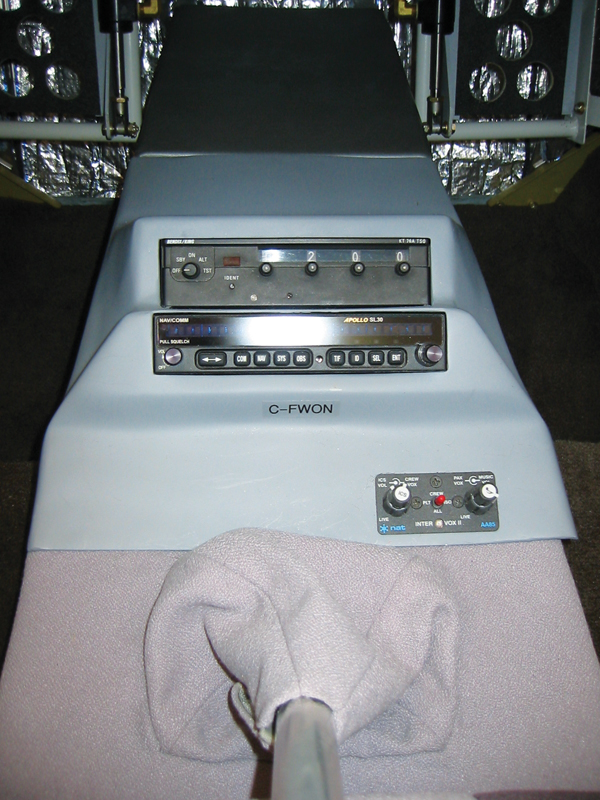
Interior fairings and panels provide the builder with plenty of opportunity for non-structural customization.
The $100 Hamburger
When they first learn that we fly, some of our non-flying friends will ask, “Where do you go?”
“Oh, often we just fly somewhere for lunch.”
“Do you have a favorite place?” they ask, thinking in terms of their local watering hole.
“Well, one of our favorites is a little Cajun restaurant in Welsh, Louisiana.”
“Wait—you mean you fly to Louisiana just for lunch?”
“Uh-huh.”
Owning an airplane changes one’s perspective. Cajun Tales is only 40 minutes away. In less time than many people spend on their daily commute, we are in a different state, enjoying truly local cuisine.
Weather and Equipment
Having a faster airplane means covering larger parts of the country, which leads to greater potential for encountering weather. This led to the decision to equip the plane with onboard NEXRAD and aviation weather, along with a capable EFIS with synthetic vision and an autopilot. Compared to my prior experience flying bug-smashers with steam gauges, this combination reduces the risk and workload associated with single-pilot IFR operation, freeing the pilot to talk with air traffic control and monitor the big picture, while the airplane does most of the flying itself.
Last year, we flew to Kentucky to look at a friend’s airplane. We left in the morning with clear blue skies, had a good look at the airplane, and enjoyed a leisurely lunch. On the return trip, we climbed through a high cloud layer and circumnavigated a massive thunderstorm that had built up over Louisiana, but the thunderstorm for us was a non-event. A long time before it could be seen through the canopy, a big red blotch appeared on NEXRAD. All it took to avoid was a few clicks on the bug while 100 miles out. Thirty minutes after the heading adjustment, the thunderstorm passed harmlessly off our left wing while we enjoyed smooth flight between layered wisps of cloud before landing back at home base in time for dinner.
With no overall headwind or tailwind to speak of, our cruise settled into 183 knots true, burning 10.5 gph lean of peak, which works out to approximately 17.5 nautical miles per gallon, or 20 statute miles per gallon; only slightly less mileage than our car, while travelling at over three times the speed. With 53 gallons of fuel on board, this provides a theoretical no-reserve range of 1062 statute miles. However, as a sufferer of TB (tiny bladder), a fuel stop is planned every few hours, in any case.

In the original panel, the EFIS and various indicators were located under Plexiglas for a clean look.
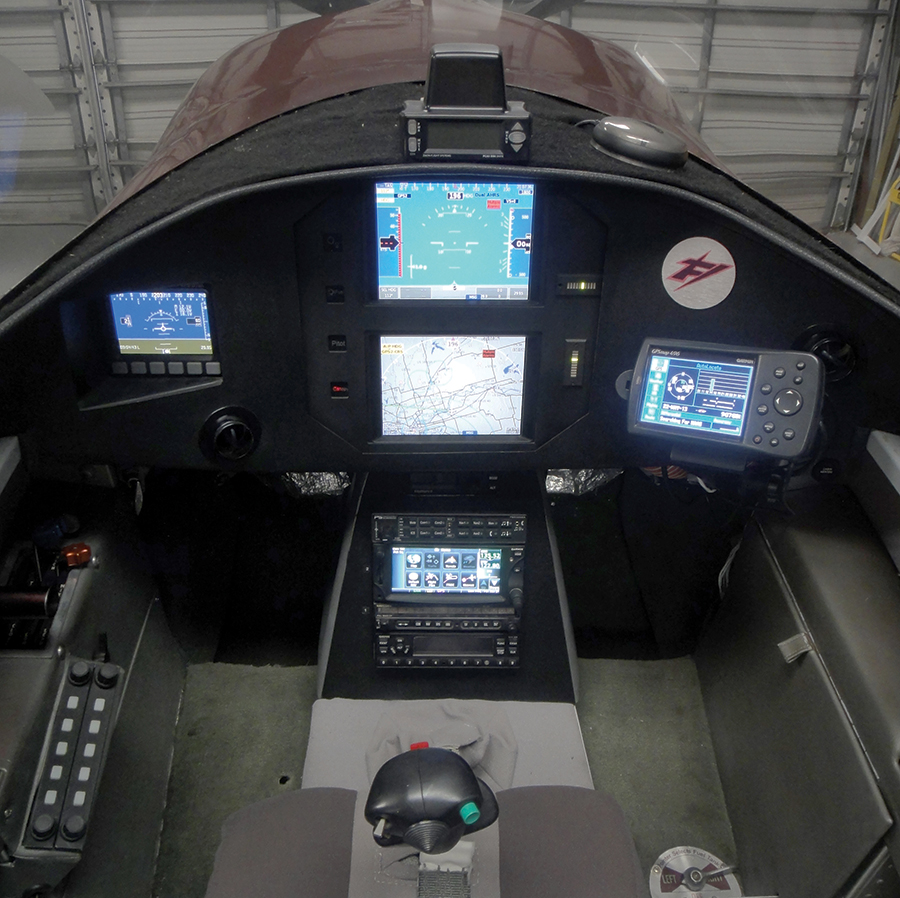
The panel still looks clean, but now has two GRT Horizon HX screens with two AHRS units, and a Dynon D10A for independent backup. There’s also a TruTrak autopilot.
Spousal Support
Of course, building an airplane is not possible without spousal support, unless you don’t have one or plan not to have one. One of the ways to help gain that support is the promise of future romantic getaways. Valentine’s Day of 2009 provided just such an opportunity.
Around 2001, the Lajitas Golf Resort and Spa near Big Bend National Park was developed as a luxury resort for high-end clientele, complete with its own private, paved airstrip. The developers invested a significant amount of money making things happen, but unfortunately, things didn’t happen. It seems the relatively few people who were willing to spend big vacation dollars didn’t place this remote corner of Texas very high on their destination list. However, this proved to be fortuitous for the average vacationer, as the resort was purchased out of bankruptcy for pennies on the dollar and opened up again with more modest prices.
You may have heard that Texas is a pretty big state. Big Bend is 692 road miles from Houston, or 10 hours by car. However, it is just over 2 hours by air, making a very convenient weekend getaway. As part of a promotion to entice visitors, a Valentine’s Day special was offered, which included rooms, a five-course meal, roses, champagne and chocolates, and a complimentary spa treatment for the ladies and a complimentary “shoot like a cowboy” event for the guys.
Needless to say, the champagne and chocolates were a big hit with one of us, and shooting a double-barreled shotgun out the door of an outhouse (a la “Billy the Kid”) was a big hit with the other. Being shuttled between our private airplane and a luxury suite didn’t hurt in the brownie points department, either.
It was fun to sit in the hotel bar and be asked how we got there.
“Oh, we came in our own plane.”
Travelling to Mecca
One of the mandatory destinations for anyone who has built their own airplane is AirVenture, in Oshkosh, Wisconsin. Prior to completing the Rocket, getting to Oshkosh with our bug-smasher was a two-day affair. This is not to say that low and slow doesn’t have its own rewards (see “Low and Slow to the Dry Tortugas,” Kitplanes Sept. 2013), but there’s something to be said for having the option to do it in five hours.
Although one of us has declared the statute of limitation to be four days in a tent, camping beside a self-built airplane and basking in the camaraderie of thousands of fellow builders and flyers is an experience both members of a couple can enjoy. It’s a magical contrast to pack up the campsite in Oshkosh after lunch and be home in time for dinner.
The French Quarter
In 2009, a half-day seminar was offered at New Orleans Lakefront Airport that looked like it would be fun, so we launched shortly after daybreak and landed in the land of “Le Bon Temps Roul” an hour and a half later.
After the morning seminar, we took a cab into town for lunch and enjoyed a sunny afternoon strolling around an outdoor art festival that covered the sidewalks over several city blocks. This is an excellent destination for a walking tour or soaking up some culture just a wee bit different from back home.
This was our first visit, and after experiencing the sights and smells of Bourbon street during the daylight, I can certainly see the attraction of returning at night for someone who is younger and perhaps single.
Stop Flying Naked
After a hundred hours, we decided it was time to take a break from flying and get the plane painted. This is one of those questions that every builder faces. One perspective is that paint is something that should be done only after the flying and tweaking is done. There is a lot of value in this perspective. It can be quite traumatic to cut into a beautifully painted panel. Also, waiting for paint means you get to fly sooner, and when the end of the project is near, the desire to fly can be significant.
On the other hand, if the airplane is a well developed kit with plenty of examples flying, the chances of needing to make changes to painted parts are significantly less, and there is one big problem with painting an airplane that is already flying: It has to stop flying to be painted. There are plenty of cases of builders who keep flying their airplane for years without any paint on it because they love to fly and can’t bear the downtime it would require.
We spent hours thinking of different paint schemes and even hired a local artist to help us flesh out some ideas. Finally, we thought we had something close and that’s when we met Raymond Baez at Big Red Customs, who specializes in custom paint jobs for cars, trucks, and motorcycles. We went through several more designs with Raymond until one day, we went to his shop and he showed us a sample plate with his latest idea for our plane. Immediately, we knew we had it. Using the style from his template, the rest of the design process went quickly; and a few weeks later,
Raymond, his crew, and equipment arrived at our hangar. Using bulldog clips, they hung dropsheets from the rafters and set up a ventilation fan at one end to exhaust the fumes out the door.
I was quite surprised to come home one day and find all of the parts were black. As it turns out, black is the best color to use for primer when you are spraying a silver base coat. I guess that’s why they call them professionals—I never would have thought of using black.
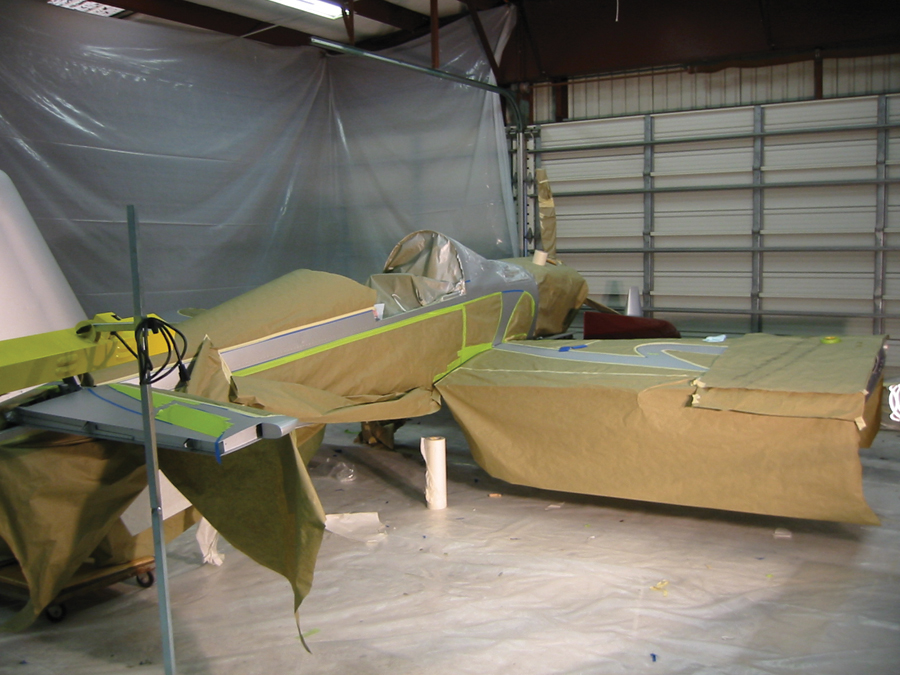
A magical paint transformation: The scheme was designed and painted by Raymond Baez and his crew from Big Red Customs.
We used a base coat/clear coat system with PPG brand paints. HVLP guns were used to keep the overspray down. I think in the end, the job took longer than any of us estimated—the crew was on site for most of about six weeks, but they held to their original estimate for the cost of the work, and I am very pleased with the final result. In fact, Raymond went out of his way to add extra touches. For example, we decided that we would not put the registration across the back of the tail, which left a large, open canvas on which Raymond airbrushed the “F1” logo that my wife Avril designed. He did all this at no extra cost.
Painting the airplane really transformed it. Before paint, it was just another unfinished airplane at a fly-in. After paint, people would come from all over the field and make nice comments, which of course makes a builder feel pretty good about all the flying time given up to make it happen.
Unplanned Maintenance
Of course, life with an airplane is not always sunshine and roses. We were one of the early adopters of an EFIS system and selected one with lots of whiz-bang features that we thought would be reliable, given it was on its second generation. Unfortunately, this proved not to be the case, as within a couple of years, the motherboard fried and the processor departed this earth, leaving us with equipment for which replacement parts had already gone out of production and were no longer available. To make matters worse, the company which made it had followed a similar path and also sizzled out of existence. This was the first unplanned maintenance item for our airplane, and it was a doozy, requiring a replacement EFIS and autopilot, and all of the associated rewiring and mounting. Fortunately, the replacements (a dual-screen GRT HX system and TruTrak autopilot) have proven to be much more reliable.
The second instance of unplanned maintenance was a slight stumble at takeoff power, which was resolved with the installation of a longer pushrod.
The third instance was what appeared to be a faulty radio. After a couple of hundred hours of trouble-free operation, it failed to turn on. It was returned to the manufacturer, where it bench checked fine, but it continued to fail when installed in the airplane. This was puzzling, as the voltage on the radio tray pins was exactly what it needed to be. The puzzle was resolved when doing the same check using lockwire and alligator clips on the backside of the pins while the radio was installed; as soon as the radio was turned on, the voltage dropped below a useable level. In this case, the problem was caused by a poor crimp, allowing the full voltage to pass with no load, but not enough as soon as a load was applied.
Fortunately, none of these events left us stranded at another airport. In the case of the EFIS, backup instruments got us home. The stumble was an annoyance and a high priority to address, but didn’t prevent flight, and a second radio meant failure of the first wasn’t a big issue.
Of course, now that I have touted the lack of unplanned maintenance, I’ve probably jinxed myself. Fingers crossed…
Ride, Comfort and Predictability
Some people look at the Rocket and think it looks pretty cramped in the cockpit. No question, it’s not built for two “Bubbas,” but I am 6 feet 4 and 180 pounds, and my better half is 5 feet 6 and [censored] pounds. While the cockpit is not spacious, it’s comfortable for the two of us, and we regularly fly legs of up to three hours or more with all our camping gear stowed behind the seat.
On the ground, warm temperatures can be tamed by taxiing with the canopy open; and in the air, the greenhouse helps keep things warm in the sunshine, moderated by reasonably effective cabin heat and ventilation.
One of our better decisions in the comfort department was to upgrade from “Brand X” seats to Oregon Aero. It used to be that we would exit the airplane feeling stiff and sore, but now we just feel a bit stiff; the soreness has gone.
Some passengers have claimed to be claustrophobic and a bit worried prior to climbing in, but any concerns quickly evaporate under the bubble canopy, which yields a very open feeling. Despite the snug cockpit, the view outside is expansive. Almost everyone who flies for the first time comments on the good visibility, and that’s from the back seat.
As a general rule, airplanes with higher wing loadings will provide a smoother ride in turbulence. Compared to the Cub-like wing loading of other airplanes we flew before, the Rocket feels like an upgrade to luxury shock absorbers. Of course, a healthy climb rate provides the ability to quickly get above the clouds, where the air is almost always smoother than down below. In addition, the quick roll rate (360 degrees in something under two seconds) and huge control response means that there is plenty of authority to tame gusty crosswinds. In 10 years of flying, we have never felt uncomfortable in turbulence or reached anywhere close to full control deflection with gusty winds on short final.
Landings are much easier than other taildraggers I have flown and are comparable to RV-type aircraft, with similar stall speeds and very predictable ground handling. Again, in 10 years of flying, we have never wandered more than a few feet from the centerline.
Downsides and Upsides
So, what are the downsides of owning and flying our time machine? Other than the obvious ones regarding cost of ownership and operation that apply to any Experimental aircraft, I really can’t think of any. Scheduled maintenance costs are pretty reasonable (mostly tires and oil), and as the builder of the airplane, the annual inspection labor cost is zero (not counting my time). We are fortunate to live on an airpark, so hangar costs are not a factor, and insurance (liability only) is under $500 per year.
Of course, there are only two seats, so it’s not well suited for the whole family, unless both spouses fly his and her airplanes.
Some people have vacation homes and complain that it can be a bit of a chore, having to regularly visit and do maintenance. Similarly, owning an airplane and keeping the oil bathing the mechanical components means having to fly regularly, but somehow, this doesn’t seem like so much of a problem.
However, being able to walk out the door to a waiting airplane and immediately experience adventure is an experience that is difficult to put a price on. And regardless of high wing or low wing, fast or slow, being able to participate in aviation within a community of aviators is an amazing experience.
Ten years on, our time machine is a part of our life that is hard to imagine being without.
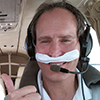
![]()
Dave Forster has built 3 airplanes, 1 helicopter and 1.5 cars. He lives on an airpark in Texas with his wife and Australian Kelpie, where he is trying to figure out what to build next and what he wants to be when he grows up.


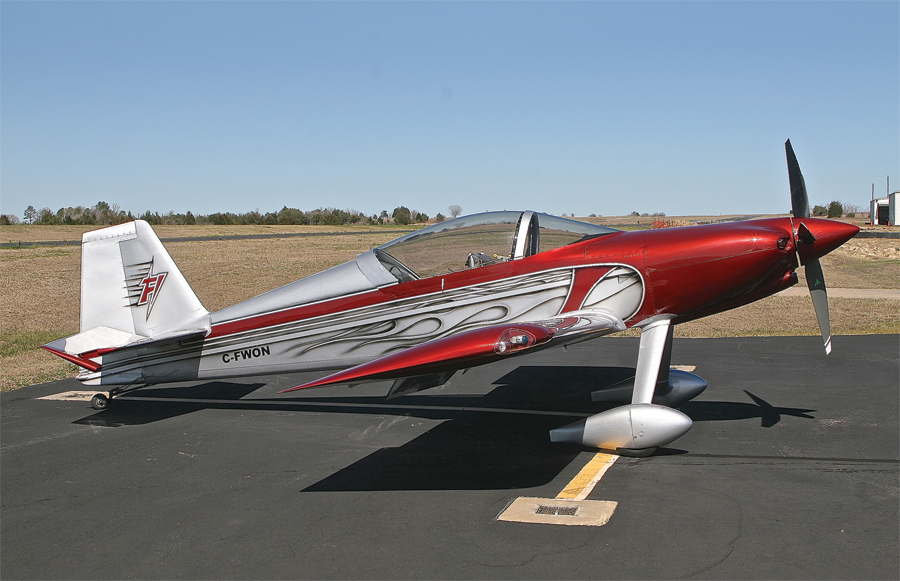

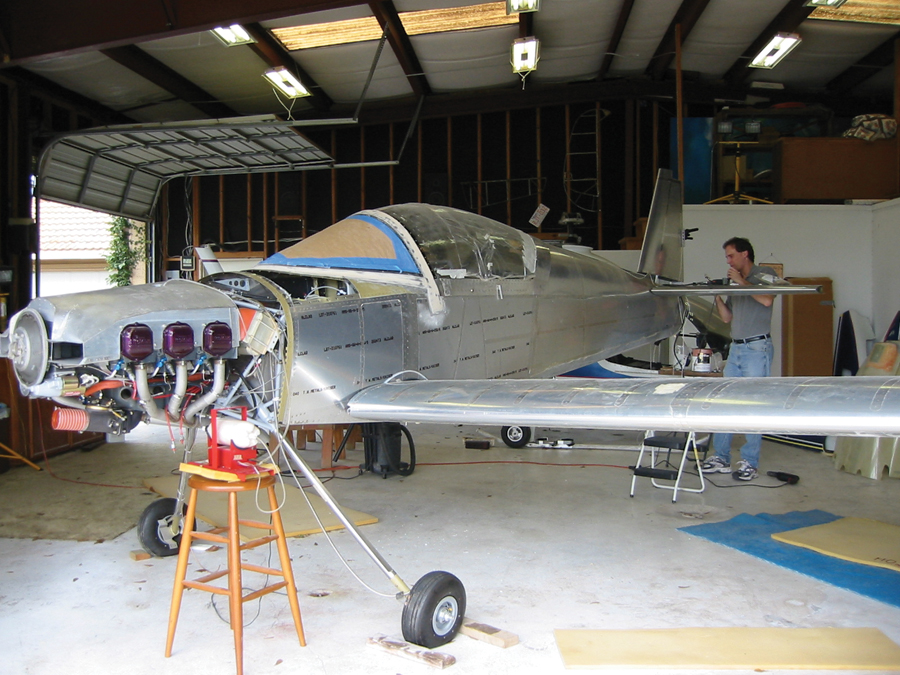
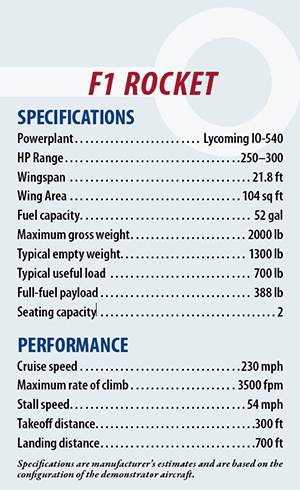
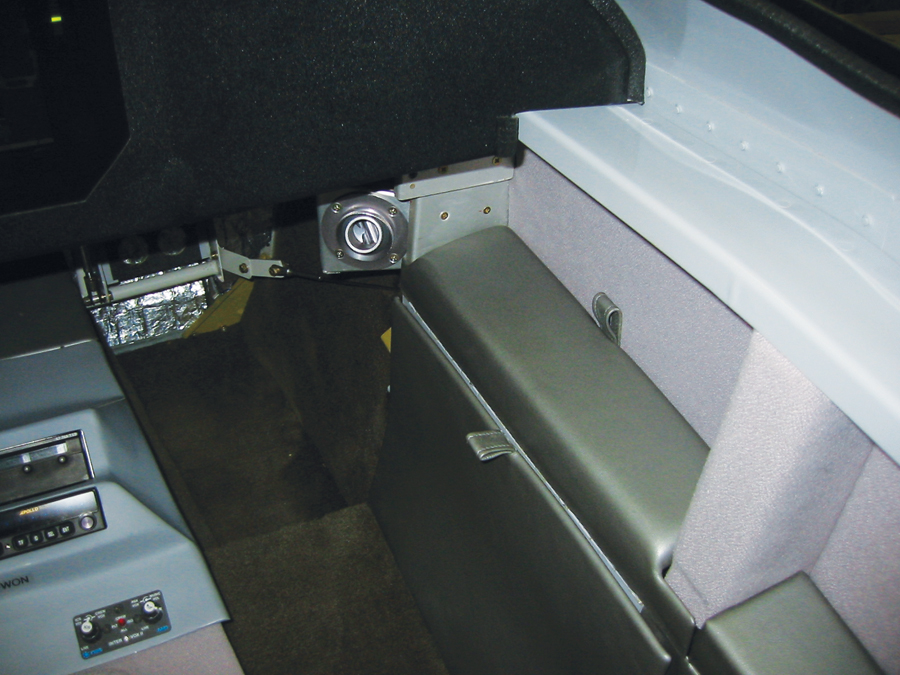
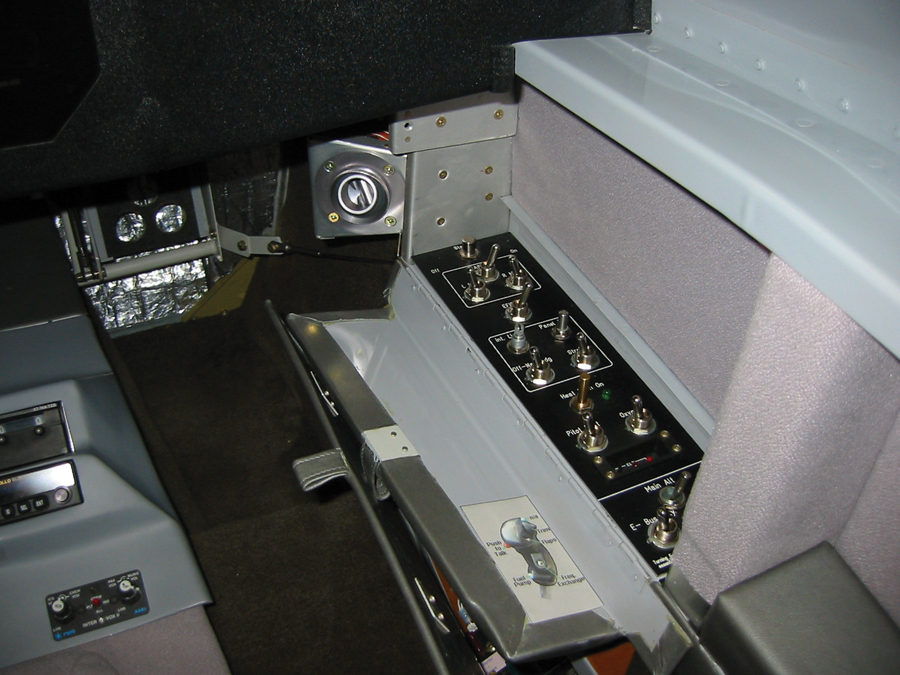


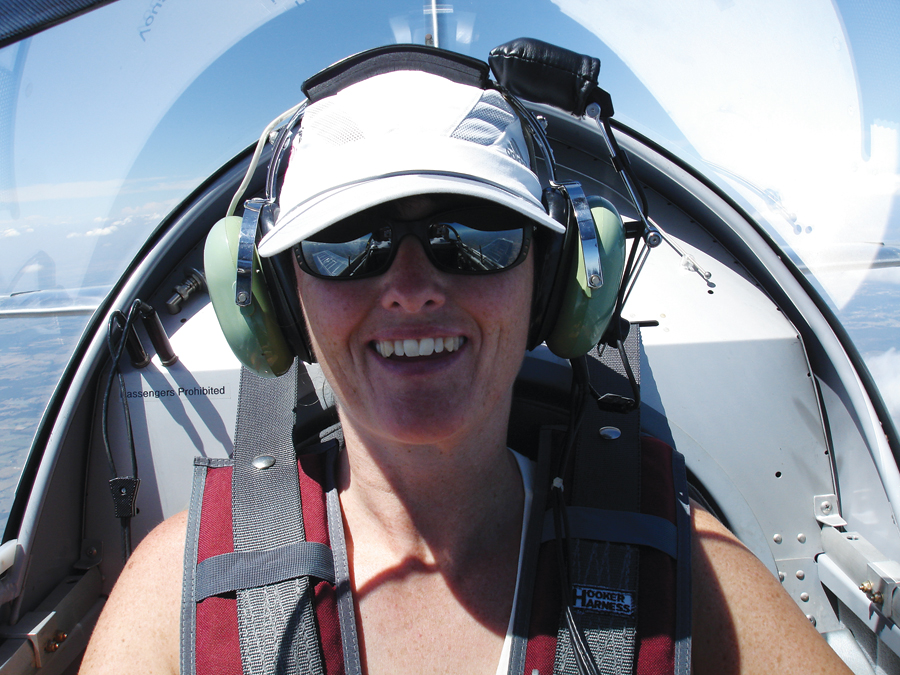
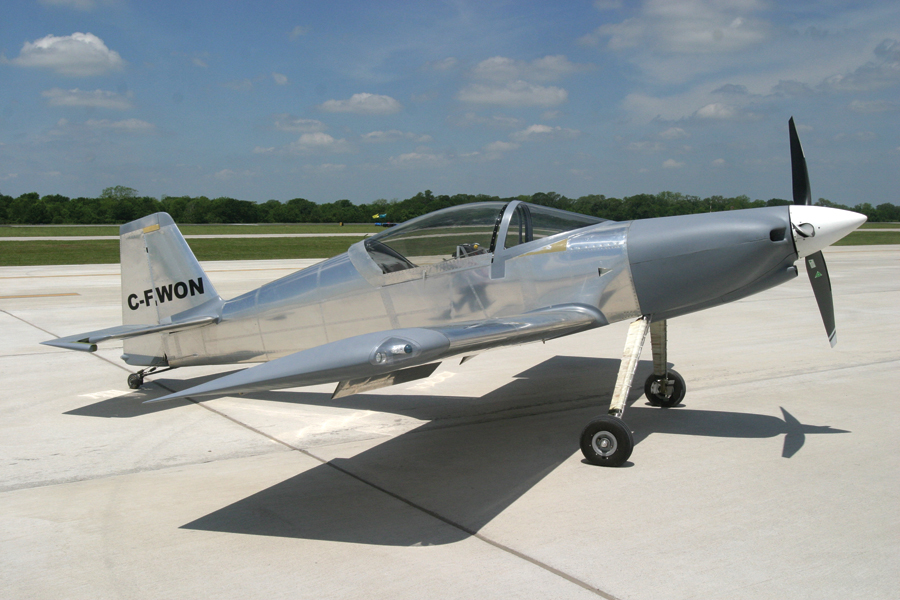
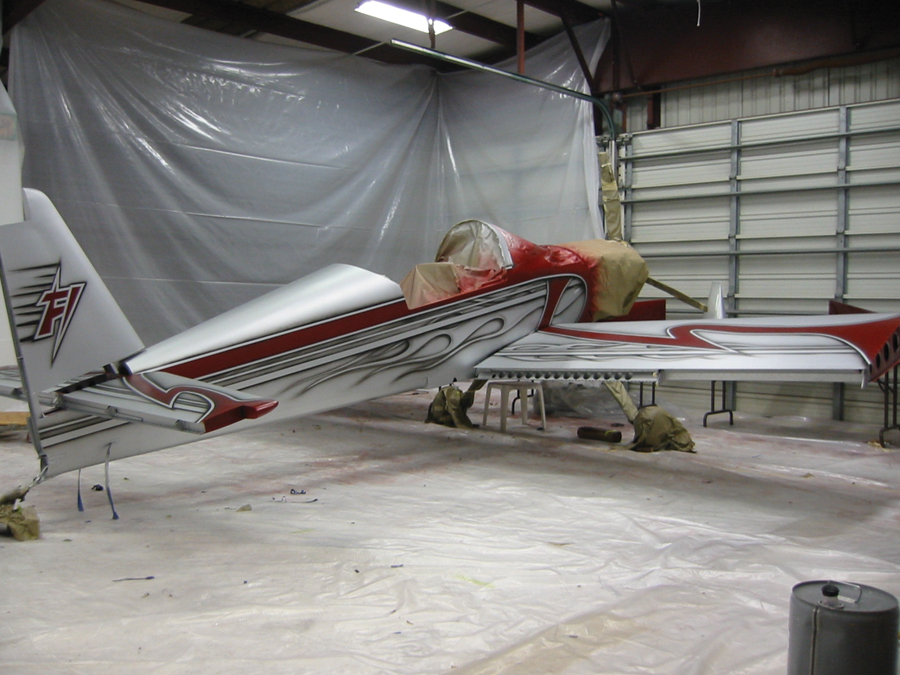

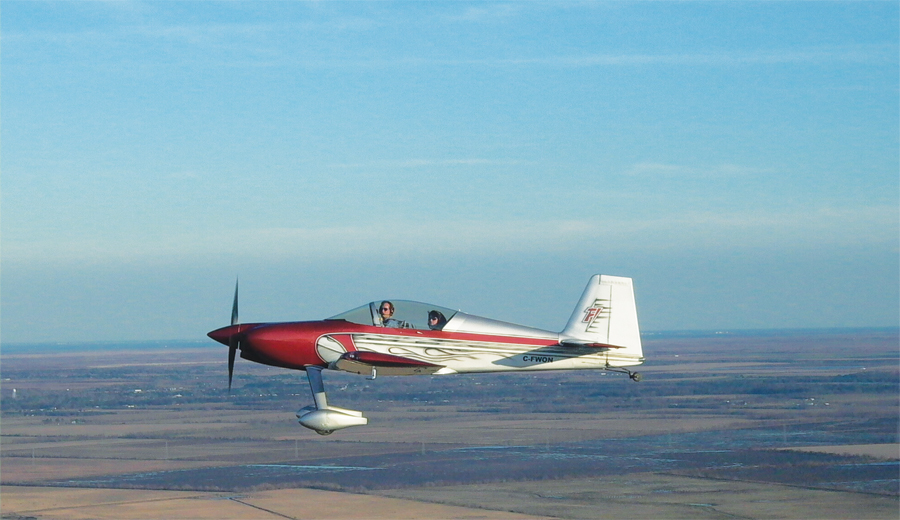








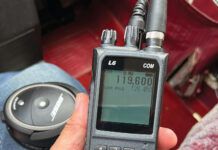

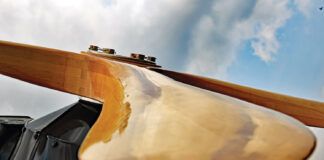
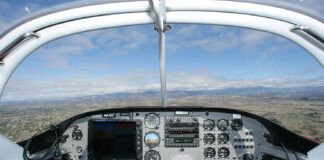
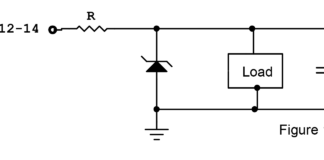
Dave. I had lost you name from last year at osk i’am the yellowRV6, I hade wondered through out the year if you had got out of that storm that week would have called but lost your number, a friend gave me this article so here i’am saying hi
Gary Mason
307 689 6336
What’s the difference between the F1 and the Harmon?
Mrs. Harmon always wanted to get there faster, hence the birth of the Harmon Rocket!
As a result of liabilities I gave up working on certain projects, on the advice of a good lawyer friend. Especially regarding aviation work.
Mech./Elect. Eng. happily retired
The Harmon Rocket started with an RV4 kit from Van’s aircraft and substituted various parts to make the Harmon Rocket. The F1 Rocket is similar to the Harmon Rocket, though the fuselage is closer to an RV8 and it has a number of other design changes, including thicker skins and titanium gear legs. The F1 was produced as a quick build kit with all the kit-specific parts purchased from one source.
The above article was written in 2015. Support for the F1 can now be found at https://f1aircraft.com/